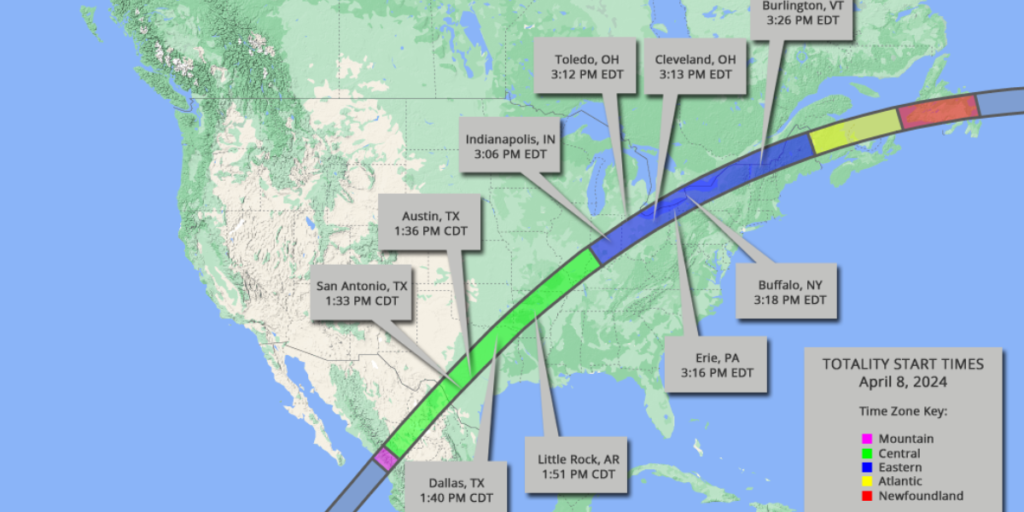In the vast cosmic theater, where celestial events unfold with breathtaking precision, the impending total solar eclipse of 2024 stands out as a rare and awe-inspiring spectacle. As sky-gazers eagerly anticipate the first celestial event of the year, we embark on a journey to explore the profound significance of a total solar eclipse, unravel the intricate dynamics that orchestrate such cosmic phenomena, and delve into the details surrounding the timing, path, and unfortunate exclusion of India from the viewing experience.
Table of Contents
Total Solar Eclipse:
At the heart of the total solar eclipse lies a mesmerizing celestial alignment. NASA, the foremost authority on space exploration, defines a total solar eclipse as the result of the Moon positioning itself between the Sun and Earth, casting a shadow that completely obscures the Sun’s face. This alignment not only darkens the skies but also grants a privileged few situated in the Moon’s central shadow the rare opportunity to experience a total eclipse – a moment when the Moon fully covers the Sun, creating an otherworldly scene akin to twilight.

This unique cosmic event captivates astronomers, scientists, and casual observers alike, offering a brief but captivating glimpse into the intricate dance of celestial bodies that has been occurring for eons. NASA emphasizes that the total solar eclipse is the only instance where viewers can safely remove their eclipse glasses, specially designed to protect against the Sun’s intense rays, during the brief period when the Moon entirely blocks the Sun.
Marking the Calendar: Solar Eclipse 2024 Timing and Path:
The eagerly awaited date for this celestial marvel is April 8, 2024. The cosmic ballet will commence over the vast expanse of the South Pacific, and its celestial journey will unfold with a majestic path reaching Mexico’s Pacific coast at approximately 11:07 a.m. Pacific Time (12:37 am IST). The eclipse’s trajectory will then traverse the United States, making its way through the states of Texas, Oklahoma, Arkansas, Missouri, Tennessee, Illinois, Kentucky, Indiana, Ohio, Michigan, Pennsylvania, New York, Vermont, New Hampshire, and Maine.
The celestial path doesn’t stop there; it continues its journey northward, venturing into Canada. Residents of Ontario, Quebec, New Brunswick, Prince Edward Island, and Cape Breton will be treated to the eclipse’s celestial ballet. The grand finale of the eclipse’s North American tour will occur on the Atlantic coast of Newfoundland, Canada, at 5:16 p.m. Newfoundland Time, as reported by Reuters.

Absence of Visibility in India:
Regrettably, for those residing in the Indian subcontinent, the total solar eclipse of 2024 will not be visible. This exclusion, however, does not diminish the global significance and splendor of the event. While India may not be under the eclipse’s shadow, the world unites in shared anticipation and appreciation for the cosmic wonders that unfold beyond our terrestrial borders.
Guidelines for Safe Eclipse Viewing:
As we prepare to witness this cosmic ballet, it is crucial to prioritize eye safety during the solar eclipse. NASA underscores the necessity of using proper eye protection or indirect viewing methods, especially during the partial phases of the eclipse. The Sun’s intense rays can cause permanent eye damage, and precautions must be taken to ensure a safe and enjoyable viewing experience. Here are some recommended methods for safely observing the total solar eclipse:

- Projection Technique:
- Utilize a telescope to project the Sun’s image onto a whiteboard, providing a safe and clear view of the eclipse without directly looking at the Sun.
- Eye Filters:
- Employ specialized eye filters, such as black polymer, aluminized Mylar, or welding glass with a shade number of 14. These filters ensure that the solar eclipse can be observed without risking eye damage.
- Eclipse Glasses:
- Invest in eclipse glasses, designed explicitly for solar viewing. These glasses block harmful solar radiation, allowing for a secure and unobstructed view of the celestial event.
- Indirect Viewing:
- Construct a pinhole projector or use other indirect viewing methods to witness the progression of the eclipse without direct eye exposure to the Sun.
The Global Excitement:
As the world eagerly anticipates the total solar eclipse of 2024, a sense of unity and shared excitement permeates the global community. Despite geographical boundaries, cultural differences, and varying levels of astronomical knowledge, the celestial spectacle serves as a reminder of the interconnectedness of humanity under the vast canvas of the universe.

In the cosmic symphony of celestial events, the total solar eclipse of 2024 emerges as a star-studded performer, captivating hearts and minds across the globe. The intricate dance of the Sun, Moon, and Earth unfolds a celestial ballet that transcends borders and brings people together in collective awe. While India may miss the direct gaze of the eclipse, the global community stands united in anticipation, armed with knowledge on safe viewing practices to ensure an unforgettable experience.
As the countdown to April 8, 2024, continues, let us marvel at the cosmic wonders that unfold above, reminding us of the profound beauty and mystery that permeate our universe. The total solar eclipse beckons us to look skyward, embrace the celestial spectacle, and revel in the shared fascination that unites humanity under the cosmic canopy.

